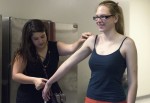Ackerman Grand Ballroom will be transformed into a glitzy, glamorous showcase of the latest student-designed styles when it hosts the annual Fashion and Student Trends fashion show Friday.
FAST at UCLA will put on the student-produced show to give students a real runway experience, said Silvia Wong, a member of the FAST executive board.
Wong, a third-year communication studies student, said the group has been planning the event since the beginning of the year, shaping its vision for lighting and layout of the show through weekly meetings and discussions.
Wong added that the show serves as a way for student designers to feature their work and artistic talent in public, sometimes for the first time.
“(The show) displays the different designers’ perspectives and their own individual influences,” Wong said. “We decided against a theme this year because we wanted to take into account that designers get their inspiration from diverse subjects.”
Students were able to draw on their own insight, which led to collections that mirror everything from the spring floral landscaping on campus to a Paris trip taken by one of the designers, Wong said.
This year’s show features 10 student-designed collections modeled by other students, as well as two sponsored fashion lines from Teva Sandals and Los Angeles-based Shady’s Closet.
This year, FAST is also partnering with Your Voice, a nonprofit campaign created by the social media app Whisper, that aims to tackle mental health issues by offering support and resources for people who need them.
As part of this effort, the show will also host Cecilia Moreno, the publisher and editorial director of Genlux Magazine, a publication that reports about the intersection between luxury fashion and philanthropy.
Many of the designers who will have their clothing paraded down the catwalk have just recently started to try their hand at the sewing machine and have spent the entire year getting their collections ready for the stage.
Stephanie Loo, a fourth-year arts and architecture student, has been involved in FAST since her first year at UCLA but said that this is her first time participating in the show as a designer.
Loo said that her journey into fashion design started when she made a costume for one of her friends and then progressed into makeshift methods like hand-stitching and gluing before she was able to finally secure a sewing machine.
Loo said she takes inspiration from shapes and how clothing interacts with the subject wearing it.
As a first-time designer, Loo said she utilized her background in architecture by combining the techniques she learned in school into her fashion design, repurposing a laser-cutting machine used in creating architecture models into a tool to cut geometric figures into her designs.
“I use a lot of solid colors in my pieces, my fashion is very shape-based,” Loo said. “My focus is on the geometry and how fabric will drape on the body.”
Another designer showing her creations publically for the first time is Vita Newstetter, a second-year Design | Media Arts student.
Newstetter said her experience as a designer started in middle school where she transformed old neckties into garish multicolored belts that she would strap on before going to school.
This was also the beginning of her effort to use reclaimed fabrics as the base materials in her work.
Newstetter said she found the vast majority of the fabrics for her collection in a San Francisco junk store called SCRAP, which offers a wide variety of artistic ingredients in its warehouse filled with fanciful miscellany.
“It was serendipitous, I let the fabric itself inspire what I made,” Newstetter said. “Each piece had its own trajectory; I was fascinated by the different pathways through which I could realize my vision.”
Because of the method that Newstetter used to procure her materials, she said her collection for the show lacks a certain thematic thread, instead ranging from a gold alligator print jumpsuit to a dress made out of painted green canvas that she picked out at the junk store.
Even though the fashion world has come under criticism for being out of touch with and out of reach for the general public due to its expense and extravagance, Wong said events like the FAST fashion show are meant to provoke thought and debate about culture and people’s place in it.
Wong pointed to the role fashion has in people’s daily lives, serving not only a utilitarian use, but as a wearable message to the outside world.
“(Fashion) has this transformative power that allows you to play around with aspirations and assumptions,” Wong said. “The very fact that fashion evokes some emotion in people, whether positive or negative, is important to it as an art form.”
